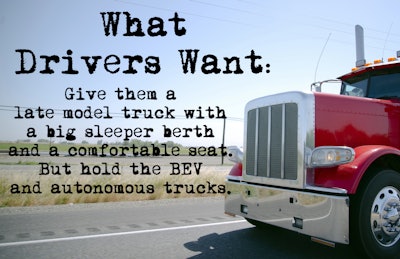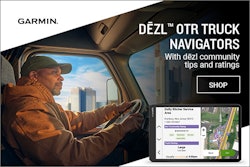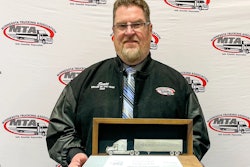
For the typical trucker who is in the driver's seat of their truck for most of their waking hours while on the road, having that seat be as comfortable as possible is a big deal.
That's just one of the things we found out in our recent survey of what drivers want.
We also found out their views on their truck's safety technology. They appreciate the safety of having a forward-facing camera but don't appreciate one aimed at them.
Drivers in our survey are not keen on battery electric powered trucks and don't believe autonomous trucks will be the saviors of the industry some people see them as.
Which creature comforts matter most?
We asked company drivers, “Which of the following truck/equipment features are important to you? Check all that apply.”
Here are the results:
- 67% – Special seat that improves comfort for long hours of driving
- 56% – Auxiliary power unit
- 47% – Late model truck
- 47% – Large sleeper
- 37% – Satellite radio
- 24% – Mobile communication to stay in touch with my dispatcher (such as Qualcomm)
- 24% – Satellite TV
- 17% – Automated transmission
- 13% – Fuel economy features (aerodynamics, trailer skirts) that will help me achieve a fuel-saving bonus
- 13% – Good-looking paint job
The choice of a comfortable seat was a priority across all age groups. It was chosen by 71% of company drivers under the age of 34; by 69% of drivers 35 to 54 years old and 67% of drivers 55 years and older.
RELATED NEWS: Welcome to our new series in which we find out what's on truckers' minds
The younger drivers were vastly more interested than drivers in the other age categories when it came to wanting an APU and also having a large sleeper.
All drivers under the age of 24 said an APU was important to them. That compares to 61% of drivers in the 35-54 bracket and 54% of drivers 55 and older.
When it came to driving a truck with a large sleeper, 71% of those drivers up to age 34 said that was important. Just 47% of drivers 3-54 and over 55 said a large sleeper was important to them.
More younger drivers – 57% – said a late model truck was important than did drivers 35-54 years old – 43% – and drivers older than 55 – 48%.
And, those drivers under the age of 34 said that late model trucks ought to look good. Fully 57% said a good-looking paint job was important. Only 12% of both drivers 35-54 years old and over 55 said the paint job was important.
We asked drivers for their comments on this question and here’s a sampling of their responses:
“Inside comfort and outside looks. Truck needs to ride good, and look good.”
“Microwave, refrigerator, inverter, this will allow for fresh food, a way to cook, power for cooking.”
“Engine big enough to do the job properly.”
“Mega carriers buy equipment with the smaller sleepers, and then want you to drive forever without going home.”
“Nothing nicer than a late model truck with a big bunk at the end of the day.”
“Compared to the cabovers of the 70s, 80s, and 90s, trucks have improved to make our lives better for living. I am driving a beautiful burgundy with a cream stripe, new KWW 990. Compared to crawling into a coffin, the large sleeper is nice.”
“I need a radio I don't have to mess with to keep me informed and entertained. I need a seat that won't break my back and give me Charlie horses.”
“If you want to keep your trucks working, you have to make your drivers happy. Like giving them reliable equipment, a comfortable place in the trucks for downtime, and you have to give them wages that they can live on in the truck and at home for their family.”
“With all the anti-idle laws, an APU should be standard equipment.”
“Well maintained equipment is important. That is why I chose late model equipment because lowering the chance of break down or equipment violations is very important.”
“Premium interior with extra sound-deadening material.”
“I want a nice, old school piece of equipment. Manual transmission, horsepower, and looks good going down the road. Life is too short to drive a plastic auto truck that looks like everything else. I want, pre-ELD truck, so as to not have to adhere to the majority of the government and mechanical regulations … when everyone who's stuck on the side of the road with HOS/DEF issues … the ones who will keep the country going are the laissez-faire truckers who were able to not have to deal with the government BS.”
What technologies keep drivers safest?
Our survey also asked drivers about truck features and equipment beyond those that apply to driver’s creature comforts.
Toward that end, we asked, “Which technologies do you think have the greatest impact on truck driver safety? Check all that apply.”
Here are the results:
- 55% – Forward-facing camera
- 36% – Electronic logging device
- 35% – Lane departure warning system
- 34% – Collision mitigation system
- 23% – Lane-keeping/lane centering
- 16% – Speed limiter
- 10% – Driver-facing camera
- 6% – Telematics
More company drivers – 58% – than leased-owner-operators – 47% – said forward-facing cameras had the most impact on driver safety. Likewise for collision mitigation systems, which 38% of company drivers chose compared to 36% of the owner-operators. The responses were similar when it came to the impact lane departure warning systems. Slightly more company drivers – 38% – chose them, while 30% of owner-operators did. They two were about dead even when it came eo ELDs: 37% of company drivers chose them, while 36% of owner-operators did.
RELATED NEWS: Truckers rate the major problems they face in their lives on the road
Only forward-facing cameras and ELDs showed any real difference of opinion when age groups were taken into account.
The leading choice for 57% of drivers 35 to 54 years old was forward-facing cameras, followed closely by 53% of drivers 55 and older. However, just 45% of drivers under the age of 34 chose them as having the greatest impact on driver safety.
ELDs were said to have the most impact by 37% of drivers 55 and older, and 35% of those drivers 35 to 54 years old. However, just 18% of drivers under 34 years old chose them.
We also took the pulse of drivers when it came to bigger picture equipment. In specific, we asked about autonomous trucks and those powered by alternatives to diesel powertrains.
Are trucks meant to drive themselves?
Few developments in heavy-duty trucks have been as profound or as controversial as autonomous trucks, ones that, simply put, drive themselves. Some are being tested on the road already, but there is much speculation as to when – or if – they will ever replace ones with drivers at the wheel.
We asked, “Which statement about autonomous truck technologies do you agree with the most?”
And the answers were:
- 61% – I don’t think this technology will ever be widely deployed.
- 23% – Self-driving technologies will change the driver’s role, but there will always be a need for a person in the cab.
- 16% Self-driving technologies will eventually do away with the truck driver as we know it today.
Company drivers and leased owner-operators – 61% each – said they did not think autonomous trucks would never be widely deployed. That compares to 25% of company drivers and 20% of owner-operators who agreed there would always be a need for drivers in trucks. And, 15% of company drivers and 20% of o-o’s think drivers' days are numbered.
Responses to this question were relatively similar across the three age brackets:
I don’t think this technology will ever be widely deployed.
- 55% of drivers under 34 years old
- 59% of drivers 35-54 years old
- 62% of drivers 55 and over
Self-driving technologies will change the driver’s role, but there will always be a need for a person in the cab
- 27% of drivers under the age of 34
- 27% of drivers 35-54 years old
- 21% of drivers 55 and over
Self-driving technologies will eventually do away with the truck driver as we know it today
- 18% of drivers under the age of 34
- 14% of drivers 35-54 years old
- 17% of drivers 55 and over
But, how do they feel about non-diesel drivetrains?
Drivers in our survey were lukewarm – at best – on the idea of alternatives to diesel engines.
We asked, “How interested are you in electric and/or hydrogen powertrains?”
Here’s how drivers responded:
- 49% – I don’t care one way or the other
- 40% – I would quit before driving one
- 11% – If my fleet bought one, I would want to drive it
Only a small number beyond half (51%) of company drivers said they didn’t care one way or the other about electric and/or hydrogen powertrains. Slightly less than half – 45% – of leased owner-operators said they don’t care.
It was owner-operators who voiced the greatest objection to alternative fuel trucks. Fully 46% of them said they would quit before driving one. That compares to just 38% of company drivers who would.
Over half – 55% – of drivers 34 years old and younger said they don't care one way or the other about driving trucks with electric and/or hydrogen powertrains. The other age groups were about equally split: 50% of 35 to 54-year-olds don't care, while 49% of drivers 55 and older made that choice.
When it came to quitting before driving a non-diesel truck, that was the choice of 42% of drivers 35-54; 40% of drivers 55 and older; and just 18% of those under the age of 34.
However, the drivers in the younger age category were the most enthusiastic about driving one, with 27% agreeing with the sentiment of, “If my fleet bought one, I would want to drive it.” That compares to 11% of 55 and older drivers and 9% ages 35 to 54.
Here's who responded to our survey
A total of 812 drivers responded to our survey; 566 company drivers and 246 leased owner-operators. Most – 53% – are over-the-road long-haul drivers.
These are mostly veteran drivers, part of the mature cadre of truckers many in the industry worry will soon begin entertaining thoughts of retirement. Fully 72% of respondents are 55 years old or older; 27% are between the ages of 35 and 54 while just 2% are 34 and younger.
Respondents are also drivers who have spent much of their lives on the road: 69% said they have driven for 20 years or more; 8% have driven 16 to 20 years; 6% for 11 to 15 years; 8% 6 to 10 years; and 7% for 5 years or less.
They are also serious road warriors with the miles to prove it. Twenty-six percent said they drive between 100,001 and 125,000 miles a year and the same number typically log from 75,001 to 100,000 miles. Another 17% drove between 125,001 and 150,000 miles and 8% logged over 150,00.
And, what did they get for all those miles?
Slightly more than half – 53% – said they earned a net income of over $75,001 in the last year; 31% earned $75,001 and $100,000 and 22% said they earned $100,000 or more.












